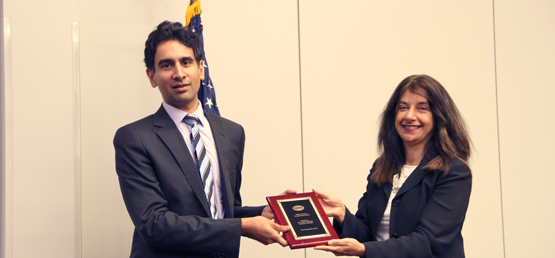Prof. Raj Nadakuditi awarded DARPA Young Faculty Award for research that could help reveal the brain’s secrets
His research will impact the ability to investigate the structure of brain circuits through the use of optical imaging techniques.

 Enlarge
Enlarge
Raj Nadakuditi, assistant professor of Electrical and Computer Engineering, has received a 2014 Young Faculty Award from the Defense Advanced Research Projects Agency (DARPA) for his research project, “Fundamental limits of eigen-wavefront based imaging through highly scattering random media.” His research will impact the ability to investigate the structure of brain circuits through the use of optical imaging techniques.
On a broader scale, this research is directly applicable to the Brain Research through Advancing Innovative Neurotechnologies (BRAIN) Initiative that is aimed at revolutionizing our understanding of the human brain. Researchers in the field have long believed that new ways to treat, cure, and even prevent brain disorders will be possible once we have a better understanding of how the brain works. Technology is now at point where this is becoming possible.
Contemporary methods used to reveal the basic structure and operation of the brain deep below the brain surface include optogenetics and fluorescence imaging. With these techniques, neurons are sensitized or dyed to fluoresce with light.
However, the scattering of light by brain tissue during these processes limits the penetration depth of the light and thereby prevents the imaging of deep brain circuits. Consequently, this has limited the usefulness of optical techniques for such a purpose.
Prof. Nadakuditi plans to develop a method that will mitigate the loss in image quality due to the multiple scattering of light in non-transparent media, which includes brain tissue.
This method involves exploring the theoretical limits of imaging using highly-transmitting eigen wave fronts, and then designing specially created algorithms that will enable dramatic gains in transmitting power and penetration depth.
“The increased transmitted power will amplify the optogenetic or fluorescent effect,” says Prof. Nadakuditi. To test and refine his theoretical predictions, Prof. Nadakuditi is collaborating with Prof. Eric Michielssen, a renowned expert on computational electromagnetics.
Prof. Nadakuditi ‘s research is focused on statistical estimation and learning, signal processing for sensing and sensor networks, random matrix theory and applications, random graphs and light transport through opaque random media.
After receiving his Ph.D. degree in electrical engineering and computer science from MIT in 2007, Prof. Nadakuditi remained at the university as a post-doctoral research associate until joining the University of Michigan faculty in the fall of 2009. He has previously received the ONR and AFOSR Young Investigator Awards.
He has taught a variety of undergraduate and graduate level courses, including: Advanced Signal Processing and Applications (EECS 498); Random Matrix Theory and Applications (EECS 598); and Matrix Methods for Signal Processing, Data Analysis and Machine Learning (EECS 551).
Prof. Nadakuditi was presented with the award at the DARPA Young Faculty Award kickoff meeting, October 3, 2014, at DARPA headquarters in Arlington, Virginia.
About the DARPA Young Faculty Award
According to DARPA, “The objective of the DARPA Young Faculty Award (YFA) program is to identify and engage rising research stars in junior faculty positions at U.S. academic institutions.”
“The long-term goal of the YFA program is to develop the next generation of academic scientists, engineers and mathematicians in key disciplines who will focus a significant portion of their career on DoD and national security issues.”
 MENU
MENU 
